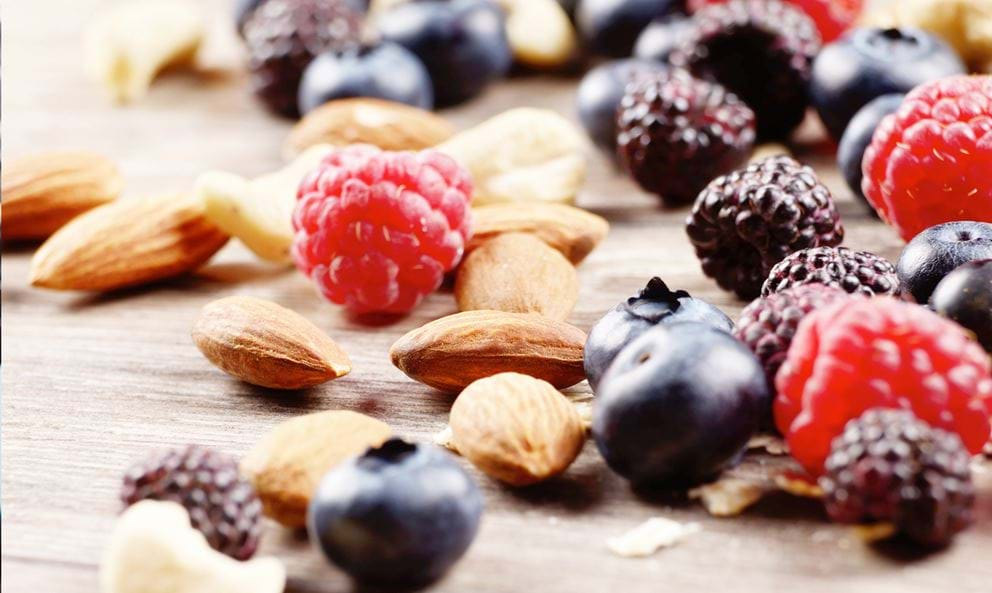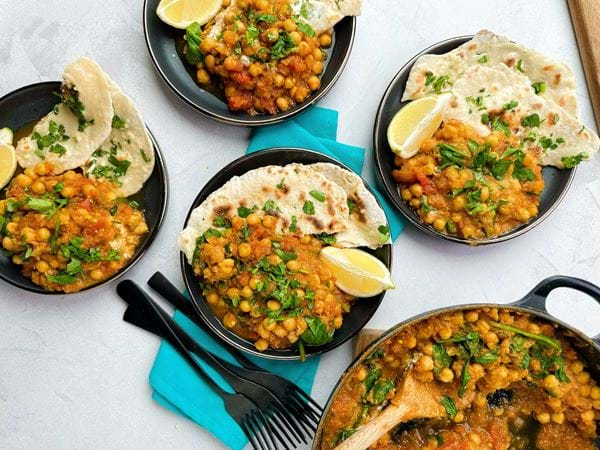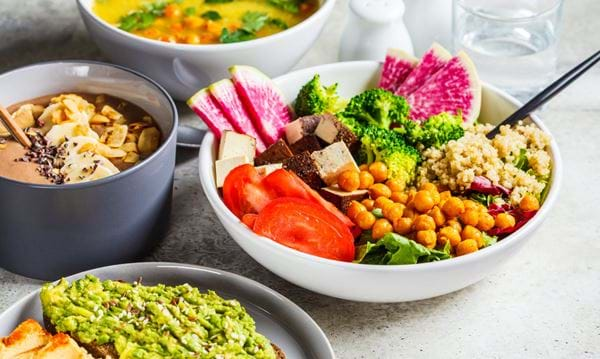What’s the Healthier Snack: Fruit or Nuts?

Page Last Updated: 22nd October 2021
Fruit and nuts are healthy — a simple statement that’s hard to disagree with. But when it comes to the question of which is best, things become quite a bit more complicated.
‘Healthier’ in what way? ‘Better’ for what?
It should come as no surprise that different fruits and nuts do different things, and each can be great depending on the time and situation they’re consumed in.
Here, we consider some of the major health benefits of both fruit and nuts to showcase reasons why each makes a fantastic snack option.
The Health Benefits of Eating Fruit
Well, where to start? Fruits provide a sweet tasty snack, or can easily be integrated into meals or nutritious shakes. And they are simply packed full of vitamins and minerals that are fantastic for your health. There are so many incredible benefits to including fruit in your diet, we won’t list them all here, but here are a few of our favourites:
-
Decrease the risk of diabetes: Studies have shown that a fruit-rich diet can help to prevent the development of type 2 diabetes, thanks in no small part to the boost in vitamin C it can provide[1]. Grapefruit is a particularly good choice for this[2], with around 69 mg of vitamin C in just one small fruit.
-
Lower cholesterol: Are you concerned about your cholesterol levels? Fruit can actually help to lower ‘bad’ LDL cholesterol and increase ‘good’ HDL cholesterol. Just two apples a day could be all you need to see great results[3].
-
Improve digestion and aid weight loss: Fruit is a quick and delicious way of supplying our bodies with dietary fibre, which helps to normalise bowel movements, control blood sugar levels and potentially help to lose weight[4] (amongst many other fantastic benefits). Although pretty much all fruit and veg will be good for your gut health, one single pear is packed with 20% of your daily fibre requirement (around 5.5g) so add this to your everyday meals to keep your tum in working order[5].
-
Boost bone density: As we age our bones can get weaker, causing a greater risk of injury. While strength training is great to future proof against this, getting your five a day is another excellent way to consume the minerals needed for stronger bones. Try including 50g of prunes in your daily diet for results (particularly great for postmenopausal women)[6].
-
Healthy teeth: Although sweet tasting, fruit can also actually help to decrease your risk of cavities. In fact, fibre-rich cranberries have been shown to halt the activity of cavity-causing bacteria[7] (as well as increasing gut health and vitamin C levels).
The Health Benefits of Eating Nuts
A Christmas staple, perfect in a buttery paste to smear on your toast and great for sprinkling on sweet and savoury dishes, nuts are a quick and convenient snack food. Here are some of our favourite health facts about them.
-
Improve heart health: Packed with unsaturated healthy fats, nuts help to keep cholesterol in check. They’re also great sources of omega 3. As a result, people who regularly eat nuts are less likely to have heart attacks or die from heart disease.[8] While most nuts have benefits here, studies have shown that walnuts can improve blood pressure[9] and circulatory blood flow[10].
-
Great source of calcium: Snacking on nuts will also help you to hit your daily calcium goals, helping to strengthen your teeth, bones and muscle function. Of all the nuts, almonds pack the highest calcium punch. 22 nuts will help you with around 8% of your recommended daily intake[11].
-
Boost your immune system: Nuts are an excellent source of vitamin E, which helps to maintain healthy skin and eyes, while strengthening your immune system. It’s also believed to protect against cell damage that could cause cancer. If your vitamin E levels are too low, you could leave yourself prone to infections and muscle weakness[12]. Hazelnuts are an excellent source, and one 28g serving equates to around 28% of your daily vitamin E requirements[13].
-
Aid weight loss: While many types of nuts are quite high in calories, they also have a high protein content which helps you to feel fuller for longer. A 2007 study showed that people who consumed more healthy peanut products passed significantly higher amounts of fat in their stool, showing a lower absorption of calories[14]. Including a small handful of peanuts as part of your afternoon snack might help to control your weight.
-
Supply your body with antioxidants: Nuts contain a range of powerful antioxidants that can help prevent chronic degenerative diseases such as diabetes, cancer, heart disease and obesity[15]. Enjoy some delicious pistachios, which, relative to other nuts, are a particularly rich source of these antioxidants[16].
So as you can see, both fruits and nuts offer a wealth of incredible health benefits - we’d recommend including both in your daily diet if you can.
Still wondering which is best for your fitness goals?
Here’s a look at a few common fitness scenarios and the healthy snacks best suited to them.
Looking for a low carb treat?
Berries. Berries are sweet and delicious, so it’s easy to see why so many people assume that they’re chock-full of sugar.
As a matter of fact, though, berries are among the least sugary, most fibre-rich, fruits out there.
100g of blackberries contains 4.88g of sugar and 5.3g of total dietary fibre[18]. For raspberries, that number per 100g is 4.42g of sugar and 6.5g of fibre[19], while 100g of strawberries - possibly the sweetest berry of them all - nets you 4.89g of sugar and 2.0g of dietary fibre[20].
This low sugar content makes berries the ideal sweet treat and nutrient-bomb for any dessert-lover on a ketogenic diet who’s carefully counting their carbs.
Bulking up with extra calories?
Walnuts. Walnuts are a delicious crumbly snack, and undeniably one of the easiest types of nuts to gorge yourself on in a single sitting. Like all nuts, they’ve got a great nutrient profile, boasting enormous quantities of Omega 3 fatty acids, as well as nutrients like calcium, magnesium, and potassium.
They also contain a whopping 654 calories per 100g[21], with almost all of that being in the form of healthy, satiating fats.
For the bulker or hard-gainer who can’t seem to eat enough no matter what, a few handfuls of walnuts will prove more than enough to get the job done.
Fuelling up pre- or post-workout?
Bananas. Bananas are one of the most filling fruits by far. A snack perfectly suited to the busy-but-health-conscious man or woman on the go; they’re also famously high in the mineral potassium.
Bananas happen to be one of the most calorie and sugar-dense fruits out there, with 100g of banana containing 89 calories and 12.23g of sugar5. The sugars in bananas are simple, and combined with the fruit’s incredibly low fat and protein contents (0.33g fat and 1.09g protein per 100g), they digest rapidly.
Bananas are the perfect food for getting a quick sugar release pre- or post-workout, either to top-up or replenish the body’s glycogen stores for a max effort endeavour, or to begin recovering following one.
Interested in more food tips? Check out our Nutrition & Diet pages for more info, learn about some common diet and nutrition myths, or browse all of our Recipes to find healthy meal and snack ideas. If you’re learning about nutrition as part of a healthy living regime, then heading to your nearest PureGym and booking a session with one of our expert Personal Trainers is a great way to start.
[1] https://www.bmj.com/content/370/bmj.m2194
[2] https://pubmed.ncbi.nlm.nih.gov/16579728/
[3] https://academic.oup.com/ajcn/article/111/2/307/5675325
[4] https://pubmed.ncbi.nlm.nih.gov/29902436/
[5] https://pubmed.ncbi.nlm.nih.gov/25623312/
[6] https://pubmed.ncbi.nlm.nih.gov/26902092/
[7] https://www.ncbi.nlm.nih.gov/pmc/articles/PMC4033875/#__ffn_sectitle
[8] https://www.hsph.harvard.edu/news/hsph-in-the-news/nuts-heart-health/
[9] https://pubmed.ncbi.nlm.nih.gov/19880586/
[10] https://pubmed.ncbi.nlm.nih.gov/16733237/
[11] https://www.livescience.com/51627-almonds-nutrition.html
[12] https://www.hsph.harvard.edu/nutritionsource/vitamin-e/
[13] https://www.ars.usda.gov/ARSUserFiles/80400525/Articles/AICR06_NutSeed.pdf
[14] https://pubmed.ncbi.nlm.nih.gov/17912269/
[15] https://pubmed.ncbi.nlm.nih.gov/17125534/
[16] https://www.ncbi.nlm.nih.gov/pmc/articles/PMC3140215/
[17] https://nutritionj.biomedcentral.com/articles/10.1186/s12937-016-0142-4
[18] https://ndb.nal.usda.gov/ndb/foods/2161?
[19] https://ndb.nal.usda.gov/ndb/foods/show/2374?
[20] https://ndb.nal.usda.gov/ndb/foods/show/2385?
[21] https://ndb.nal.usda.gov/ndb/foods/show/2159?


